|
|
|
Sort Order |
|
|
|
Items / Page
|
|
|
|
|
|
|
| Srl | Item |
| 1 |
ID:
173765
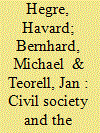

|
|
|
|
|
| Summary/Abstract |
We theorize that three distinct structures of democratic constraint explain why more democratic dyads do not engage in military conflict with each other. We build on earlier theories that focused on electoral and horizontal accountability. We add a new dimension—the social accountability provided by an active civil society. Using several new measures from the Varieties of Democracy (V-Dem) data set, we stringently test these explanations. We find social accountability to be the strongest and most consistent predictor of nonbelligerence in dyads, that horizontal accountability is still important, but that the independent role of electoral accountability has been somewhat overstated. However, we do find that social and electoral accountability work strongly together, to make for an even greater effect. The finding is robust to a range of specifications and in the face of controls for contending theories that challenge the democratic peace (e.g., the capitalist and territorial peace theories).
|
|
|
|
|
|
|
|
|
|
|
|
|
|
|
|
| 2 |
ID:
128864
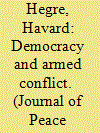

|
|
|
|
|
| Publication |
2014.
|
| Summary/Abstract |
The article reviews the literature on the relationship between democracy and armed conflict, internal as well as interstate. The review points to several similarities between how democratic institutions affect both conflict types. It summarizes the main empirical findings and discusses the most prominent explanations as well as the most important objections raised to the finding, empirically and theoretically. To a large degree, the empirical finding that pairs of democratic states have a lower risk of interstate conflict than other pairs holds up, as does the conclusion that consolidated democracies have less conflict than semi-democracies. The most critical challenge to both conclusions is the position that both democracy and peace are due to pre-existing socio-economic conditions. I conclude that this objection has considerable leverage, but it also seems clear that economic development is unlikely to bring about lasting peace alone, without the formalization embedded in democratic institutions.
|
|
|
|
|
|
|
|
|
|
|
|
|
|
|
|
| 3 |
ID:
052692


|
|
|
|
|
| Publication |
May 2004.
|
| Summary/Abstract |
An important key to reducing the suffering due to civil war is to shorten conflicts. The marked decrease in the incidence of conflicts in the 1990s was mostly due to a high number of conflict terminations, not to a decrease in the number of new wars. The articles in this special issue treat theoretically and empirically the determinants of civil war onset, duration, and termination, with particular emphasis on duration and termination. This introduction gives an overview of the articles in the special issue and discusses a few central topics covered by the different contributions: rebel group motivations, the importance of financing, military factors, misperception, and commitment problems. Finally, the article sums up some policy recommendations that may be derived from the articles in the issue.
|
|
|
|
|
|
|
|
|
|
|
|
|
|
|
|
| 4 |
ID:
083226


|
|
|
|
|
| Publication |
2008.
|
| Summary/Abstract |
Critics of trade liberalization argue that globalization increases countries' vulnerability to economic shocks and hence may exacerbate domestic social conflict. Such social conflict may also be transformed into armed conflict. Others argue that globalization promotes economic growth and reduces poverty, which leads to a reduction in the risk of internal conflict. Several studies find trade to reduce the risk of interstate conflict. This article investigates the impact of trade and trade shocks on the risk of intrastate conflict. A set of operationalizations of economic shock is developed and used to analyze the risk of conflicts that involve at least 25 battle deaths per year. The analysis finds no robust evidence for a direct relationship between trade openness, trade shocks, and the risk of armed conflict. There is somewhat more basis for concluding that globalization affects the risk indirectly through its effect on long- and short-term growth. In the long run, trade-induced growth reduces the risk of domestic conflict.
|
|
|
|
|
|
|
|
|
|
|
|
|
|
|
|
| 5 |
ID:
141188
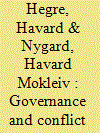

|
|
|
|
|
| Summary/Abstract |
Many conflict studies regard formal democratic institutions as states’ most important vehicle to reduce deprivation-motivated armed conflict against their governments. We argue that the wider concept of good governance—the extent to which policy making and implementation benefit the population at large—is better suited to analyze deprivation-based conflict. The article shows that the risk of conflict in countries characterized by good governance drops rapidly after a conflict has ended or after independence. In countries with poor governance, this process takes much longer. Hence, improving governance is important to reduce the incidence of conflict. We also decompose the effect of good governance into what can be explained by formal democratic institutions and less formal aspects of governance, and into what comes from economic development and what is due to how well countries are governed. We find that informal aspects of good governance to be at least as important as formal institutions in preventing conflict and that good governance has a clear effect over and beyond economic development.
|
|
|
|
|
|
|
|
|
|
|
|
|
|
|
|
| 6 |
ID:
082936
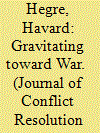

|
|
|
|
|
| Publication |
2008.
|
| Summary/Abstract |
Countries have better abilities and stronger incentives to engage in militarized conflicts the larger and more powerful they are. The article applies Zipf's notion of a ``gravity model'' to the risk of interstate conflict and argues that the empirical relationship between size and distance and conflict is stronger than any other identified in dyadic statistical studies of interstate conflict. Most empirical studies of interstate conflict fail to take size properly into account. The article shows that controlling for size variables improves the estimation of other variables of interest, and it explores the impact of omitting size variables for the investigation of the power preponderance versus power parity debate. The results indicate that even though a power capability ratio variable suggests asymmetric dyads are less conflict-prone, the risk-increasing effect of power itself means that a unilateral increase of power in one country increases the risk of conflict
|
|
|
|
|
|
|
|
|
|
|
|
|
|
|
|
| 7 |
ID:
091067
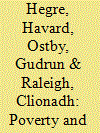

|
|
|
|
|
| Publication |
2009.
|
| Summary/Abstract |
This article examines the link between subnational poverty and the location of civil war events. Drawing on the ACLED dataset, which breaks internal conflicts down to individual events at the local level, we take a disaggregated approach to the study of conflict. Local-level socioeconomic data are taken from the Liberian Demographic and Health Survey. With geographical cells of approximately 76 km 2 as units of analysis, we test how absolute and relative welfare affect the presence and number of conflict events during the 1989-2002 Liberian civil war. We control for neighboring conflict events, distance to Monrovia and national borders, population density, diamond deposits, and ethnic affiliations. War events were more frequent in the richer locations. This may provide better support for "opportunity" explanations than for "relative deprivation" theories of conflict, but we argue that the relative weakness of the Liberian government makes it difficult to distinguish between the two.
|
|
|
|
|
|
|
|
|
|
|
|
|
|
|
|
| 8 |
ID:
120869
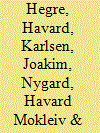

|
|
|
|
|
| Publication |
2013.
|
| Summary/Abstract |
The article predicts changes in global and regional incidences of armed conflict for the 2010-2050 period. The predictions are based on a dynamic multinomial logit model estimation on a 1970-2009 cross-sectional data set of changes between no armed conflict, minor conflict, and major conflict. Core exogenous predictors are population size, infant mortality rates, demographic composition, education levels, oil dependence, ethnic cleavages, and neighborhood characteristics. Predictions are obtained through simulating the behavior of the conflict variable implied by the estimates from this model. We use projections for the 2011-2050 period for the predictors from the UN World Population Prospects and the International Institute for Applied Systems Analysis. We treat conflicts, recent conflict history, and neighboring conflicts as endogenous variables. Out-of-sample validation of predictions for 2007-2009 (based on estimates for the 1970-2000 period) indicates that the model predicts well, with an area under the receiver operator curve of 0.937. Using a p > .30 threshold for positive prediction, the true positive rate 7-9 years into the future is 0.79 and the False Positive Rate 0.085. We predict a continued decline in the proportion of the world's countries that have internal armed conflict, from about 15% in 2009 to 7% in 2050. The decline is particularly strong in the Western Asia and North Africa region and less clear in Africa south of Sahara. The remaining conflict countries will increasingly be concentrated in East, Central, and Southern Africa and in East and South Asia.
|
|
|
|
|
|
|
|
|
|
|
|
|
|
|
|
| 9 |
ID:
101694


|
|
|
|
|
| Publication |
2010.
|
| Summary/Abstract |
Two studies question whether economic interdependence promotes peace, arguing that previous research has not adequately considered the endogeneity of trade. Using simultaneous equations to capture the reciprocal effects, they report that trade does not reduce conflict, though conflict reduces trade. These results are puzzling on logical grounds. Trade should make conflict less likely, ceteris paribus, if interstate violence adversely affects commerce; otherwise, national leaders are acting irrationally. In re-analyzing the authors' data, this article shows that trade does promote peace once the gravity model is incorporated into the analysis of conflict. Both trade and conflict are influenced by nations' sizes and the distance separating them, so these fundamental exogenous factors must be included in models of conflict as well as trade. One study errs in omitting distance when explaining militarized disputes. The other does not adequately control for the effect of size (or power). When these theoretically informed changes are made, the pacific benefit of trade again appears. In new simultaneous analyses, the article confirms that trade promotes peace and conflict contemporaneously reduces commerce, even with extensive controls for traders' rational expectations of violence. Previous studies that address the endogeneity of trade by controlling for the years of peace - as virtually all have done since 1999 - have not overstated the benefit of interdependence. Commerce promotes peace because violence has substantial costs, whether these are paid prospectively or contemporaneously.
|
|
|
|
|
|
|
|
|
|
|
|
|
|
|
|
| 10 |
ID:
072552
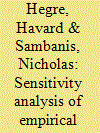

|
|
|
|
|
| Publication |
2006.
|
| Summary/Abstract |
In the literature on civil war onset, several empirical results are not robust or replicable across studies. Studies use different definitions of civil war and analyze different time periods, so readers cannot easily determine if differences in empirical results are due to those factors or if most empirical results are just not robust. The authors apply a methodology for organized specification tests to check the robustness of empirical results. They isolate causes of variation in empirical results by using the same definition of civil war and analyzing the same time period while systematically exploring the sensitivity of eighty-eight variables used to explain civil war in the literature. Several relationships with the onset of civil wars prove robust: large population and low income levels, low rates of economic growth, recent political instability and inconsistent democratic institutions, small military establishments and rough terrain, and war-prone and undemocratic neighbors. Variables representing ethnic difference in the population are robust only in relation to lower level armed conflict.
|
|
|
|
|
|
|
|
|
|
|
|
|
|
|
|
| 11 |
ID:
052822
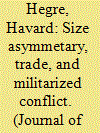

|
|
|
|
|
|
|
|